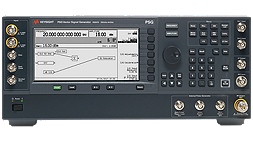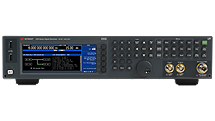Used Signal, Function + Waveform Generators
The Used Equipment web is currently available in English only and pricing is in USD for the United States.Prices for other countries will vary.
Signal generators are routinely used when designing, manufacturing, testing, troubleshooting, servicing, calibrating or repairing electronic devices. Depending on the frequency range of the signal generator and electronic device, this may range from mechanical- and electro-accoustic applications to high and ultra-high frequencies in the digital, wireless, radar spectrum.
Function-AW + Signal Generators Quick-Facts
What is a signal?
A signal is what is produced by a signal generator when testing electronic equipment. The signal can be a basic sine wave, a pulse or a modulation signal. The signals that are produced are used to test, troubleshoot and design electronic equipment.
What is a signal generator, and what is it used for?
A signal generator is an electronic testing instrument that creates repeating or non-repeating electric waves of different shapes and amplitudes. A signal generator gives clear and concise feedback about the product's performance. Signal generators are used in many different fields, but they are most important in the fields of electronics and radio communications. Engineers use this tool to test their own electronic equipment, as well as to design new equipment for other companies.
For example, a signal generator is typically on an oscilloscope. It is used to produce a sine wave (smooth curve) that can be used to test electrical signals. Learn more about oscilloscopes here.
Other types of signal generators include:
- arbitrary waveform generator
- audio signal generator
- function generator
- pulse generator
- RF signal generator
- vector signal generator
Each type provides different kinds of signals. For example, some provide radio frequency and audio, while others provide waveform or just pulses.
For a full list of Keysight signal generators, please visit our product listing page.
Why should I buy a Keysight signal generator?
A Keysight signal generator is a valuable addition to any test system because it provides the accuracy, performance, and insights you need to streamline your design or repair process. We are known for producing quality instruments in the industry, be it in digital RF processing, satellite communications, radar sensing and tracking, wireless communications or wireless & mobile test equipment.
We want you to find the signal source that's right for your needs. We have a variety of signal generators for you to choose from. They range in frequency, but they all perform well and are easy-to-use whether it's your first time using one or not.
When would I need a vector signal generator?
The vector signal generator is a type of signal generator that generates radio frequency signals with complex modulation formats. When a radio signal modulates, it changes either the amplitude or the frequency of the carrier wave.

Vector signal generators are used when testing different modern data communications systems. They are often used to check Wi-Fi, 4G/5G, and other connectivity solutions that use advanced waveforms.

Signal generator vs waveform generator
There are two types of machines for creating signals. One is called a signal generator and the other is called a waveform generator. A signal generator is an electronic test instrument that generates either repeating or non-repeating waveforms.

A waveform generator creates a wave. It is a type of signal generator that creates very sophisticated waveforms that can be specified by the user. These waveforms can be almost any shape and can be entered in a variety of ways.
Signal generator vs function generator
The function generator is a type of signal generator that is used to generate simple repetitive waveforms. Typically this type of signal generator will produce waveforms such as sine waves, sawtooth waveforms, square and triangular waveforms. Please refer to Basic Oscilloscope Fundamentals for more information on waveforms.
Digital signal processing techniques may be used to generate the waveforms digitally, then convert them from digital into analog format. This is especially true when you only require the waveforms to be at lower frequencies. However, higher frequency versions can be obtained.
Signal generator vs oscilloscope
An oscilloscope “scopes out” or monitors a given signal applied on its input. It displays the signal as voltage vs time. A signal generator can be used to generate a signal with specific characteristics to test devices.
To see the full list of oscilloscopes we carry, visit our product listing page.

A signal generator and an oscilloscope together form a tool that could, for example, diagnose an amplifier. The oscilloscope could then perform basic math on both the input and output to calculate, for example, changes in gain or linearity over a given range of parameters.
Keysight offers two standards of used equipment: Keysight Premium Used and Keysight Used. Keysight Premium Used instruments are fully refurbished to factory new condition, with the same warranty as new ones. Keysight Used equipment is tested and working with the cosmetic appearance described in each product listing.
What are EXG signal generators?
The abbreviation "EXG" stands for "exciter." An exciter is a signal generator that creates a signal and then applies it to an RF power amplifier to generate the final transmitted radiofrequency. The exciter is employed in digital systems as part of waveform generation.
EXG signal generators provide the signals you will need for basic parameter testing of components. It is a tool used to test equipment such as computers which allows users to see how the equipment will work in a variety of situations.
The EXG signal generator allows you to customize microwave components, such as filters and amplifiers, with additional features including full step attenuation. It also maximizes test margins on the production line with leading Adjacent Channel Power Ratio (ACPR).





















































